The rotating shaft seals industry stands at the threshold of a decade-long expansion trajectory that promises to reshape sealing technology and industrial equipment protection. The market's journey from USD 6,330.5 million in 2025 to USD 9,644.5 million by 2035 represents substantial growth, demonstrating the accelerating adoption of advanced sealing solutions and precision-engineered components across automotive, industrial machinery, and aerospace sectors.
The first half of the decade (2025-2030) will see the market increase from USD 6,330.5 million to approximately USD 7,813.8 million, adding USD 1,483.3 million in value, which constitutes 45% of the total forecasted growth period. This phase will be characterized by the rapid adoption of lip seal systems, driven by increasing automotive production and industrial automation programs worldwide. Advanced sealing capabilities and material durability features will become standard expectations rather than premium options.
The latter half (2030-2035) will witness sustained growth from USD 7,813.8 million to USD 9,644.5 million, representing an addition of USD 1,830.7 million or 55% of the decade's expansion. This period will be defined by mass market penetration of mechanical shaft seals, integration with comprehensive industrial systems, and seamless compatibility with existing equipment infrastructure. The market trajectory signals fundamental shifts in how manufacturing and automotive industries approach equipment protection and maintenance optimisation, with participants positioned to benefit from sustained demand across multiple application segments.
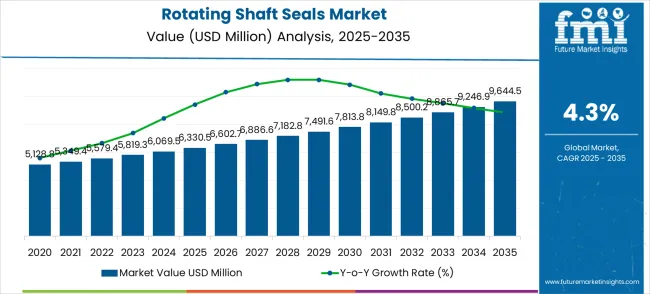
The rotating shaft seals market demonstrates distinct growth phases with varying market characteristics and competitive dynamics. Between 2025 and 2030, the market progresses through its technology adoption phase, expanding from USD 6,330.5 million to USD 7,813.8 million with steady annual increments averaging 4.3% growth. This period showcases the transition from basic sealing units to advanced systems with enhanced durability capabilities and integrated monitoring systems becoming mainstream features.
The 2025-2030 phase adds USD 1,483.3 million to market value, representing 45% of total decade expansion. Market maturation factors include standardisation of material specifications, declining component costs for advanced seal compounds, and increasing industrial awareness of equipment protection benefits reaching 90-95% effectiveness in leakage prevention applications. Competitive landscape evolution during this period features established manufacturers like Parker and Trelleborg expanding their rotating shaft seals portfolios while new entrants focus on specialised materials and enhanced performance characteristics.
From 2030 to 2035, market dynamics shift toward advanced integration and multi-industry deployment, with growth accelerating from USD 7,813.8 million to USD 9,644.5 million, adding USD 1,830.7 million or 55% of total expansion. This phase transition logic centers on mechanical shaft seals, integration with predictive maintenance networks, and deployment across diverse industrial scenarios, becoming standard rather than specialized applications. The competitive environment matures with focus shifting from basic sealing capability to comprehensive equipment protection systems and integration with condition monitoring platforms.
At-a-Glance Metrics
| Metric | Value |
|---|---|
| $ Market Value (2025) → | USD 6,330.5 million |
| $ Market Forecast (2035) ↑ | USD 9,644.5 million |
| # Growth Rate ★ | 4.3% CAGR |
| Leading Technology → | Lip Seals |
| Primary Application → | Automobile Segment |
The market demonstrates strong fundamentals with lip seal systems capturing a dominant share through advanced sealing performance and automotive deployment capabilities. Automobile applications drive primary demand, supported by increasing vehicle production of sealing systems and equipment protection solutions. Geographic expansion remains concentrated in developed markets with established manufacturing infrastructure, while emerging economies show accelerating adoption rates driven by industrial modernisation and rising automotive production.
Market expansion rests on three fundamental shifts driving adoption across automotive and industrial sectors. 1. Equipment protection demand creates compelling operational advantages through rotating shaft seals that provide immediate leakage prevention without performance degradation, enabling manufacturers to optimise equipment reliability while maintaining operational efficiency and reducing maintenance costs. 2. Industrial modernisation programs accelerate as manufacturing facilities worldwide seek advanced sealing systems that complement traditional components, enabling precise equipment protection applications that align with reliability standards and operational efficiency requirements. 3. Automotive infrastructure enhancement drives adoption from vehicle manufacturers and component suppliers requiring effective sealing solutions that minimise maintenance requirements while maintaining performance standards during high-demand operations.
However, growth faces headwinds from material cost volatility challenges that vary across supply chains regarding raw material availability and pricing stability, potentially limiting deployment flexibility in certain manufacturing environments. Technical limitations also persist regarding temperature resistance and chemical compatibility that may reduce system performance in extreme operating conditions with demanding application requirements.
Primary Classification: The market segments by product type into Lip Seals, Spring Seals, Hydraulic Seals, Mechanical Shaft Seals, and Other categories, representing the evolution from basic sealing systems to advanced protection solutions for comprehensive equipment reliability.
Secondary Breakdown: Application segmentation divides the market into Automobile, Industrial Machinery, Aerospace, and Others sectors, reflecting distinct requirements for sealing performance, equipment integration, and operational reliability.
Regional Classification: Geographic distribution covers North America, Europe, Asia Pacific, Latin America, and the Middle East & Africa, with developed markets leading adoption while emerging economies show accelerating growth patterns driven by manufacturing modernisation programs.
The segmentation structure reveals technology progression from lip seal systems toward integrated mechanical shaft seal platforms with enhanced durability and monitoring capabilities, while application diversity spans from automotive manufacturing to aerospace facilities requiring precise equipment protection solutions.
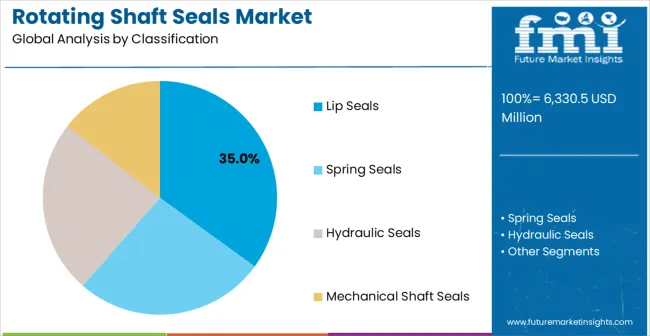
Market Position: Lip Seals systems command the leading position in the rotating shaft seals market through advanced sealing features, including comprehensive leakage prevention, extended service life, and cost-effective maintenance that enable manufacturers to deploy reliable equipment protection across diverse industrial environments.
Value Drivers: The segment benefits from manufacturing preference for proven sealing technology that provides immediate equipment protection without requiring complex installation modifications. Cost-effective design features enable deployment in automotive applications, industrial machinery, and manufacturing facilities where reliability and maintenance efficiency represent critical operational requirements.
Competitive Advantages: Lip seals differentiate through rapid installation capability, proven sealing performance, and integration with standard equipment systems that enhance manufacturing reliability while maintaining cost-effective operational profiles suitable for diverse industrial applications.
Key market characteristics:
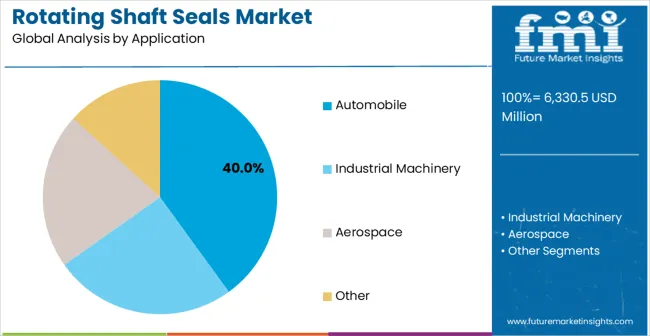
Market Context: Automobile applications dominate the rotating shaft seals market due to widespread adoption of advanced sealing systems and increasing focus on vehicle reliability, performance optimisation, and maintenance reduction applications that minimise equipment downtime while maintaining operational efficiency.
Appeal Factors: Automotive manufacturers prioritise system reliability, performance consistency, and integration with existing vehicle systems that enable coordinated deployment across multiple vehicle platforms. The segment benefits from substantial automotive production budgets and modernisation programs that emphasise advanced sealing solutions for powertrain and transmission applications.
Growth Drivers: Vehicle production programs incorporate rotating shaft seals as standard equipment for engine and transmission sealing applications. At the same time, automotive industry initiatives are increasing demand for high-performance sealing capabilities that comply with efficiency standards and minimise maintenance requirements.
Market Challenges: Material compatibility requirements and automotive specifications may limit deployment flexibility in certain vehicle platforms or operating condition scenarios.
Application dynamics include:
Growth Accelerators: Industrial modernisation drives primary adoption as rotating shaft seals provide equipment protection capabilities that enable leakage prevention without performance degradation, supporting manufacturing efficiency and operational reliability that require precise maintenance management. Automotive production demand accelerates market expansion as vehicle manufacturers seek effective sealing solutions that minimise maintenance costs while maintaining performance standards during high-demand operating conditions and production cycles. Manufacturing spending increases worldwide, creating sustained demand for advanced sealing systems that complement traditional components, providing operational flexibility in complex industrial environments.
Growth Inhibitors: Material cost volatility challenges vary across supply chains regarding raw material availability and pricing stability, which may limit deployment flexibility and market penetration in regions with restrictive cost constraints. Technical performance limitations persist regarding temperature resistance and chemical compatibility that may reduce system effectiveness in extreme operating conditions with demanding application requirements and environmental exposure. Market fragmentation across multiple industry specifications and performance standards creates compatibility concerns between different seal manufacturers and existing equipment infrastructure.
Market Evolution Patterns: Adoption accelerates in automotive and industrial sectors where equipment protection justifies system costs, with geographic concentration in developed markets transitioning toward mainstream adoption in emerging economies driven by manufacturing modernisation and industrial infrastructure development. Technology development focuses on enhanced material capabilities, improved durability characteristics, and integration with monitoring systems that optimise maintenance scheduling and equipment protection effectiveness. The market could face disruption if alternative sealing technologies or material innovations significantly limit rotating shaft seal deployment in automotive or industrial applications.
The rotating shaft seals market demonstrates varied regional dynamics with Growth Leaders including China (5.8% CAGR) and India (5.4% CAGR) driving expansion through manufacturing modernisation and automotive infrastructure development. Steady Performers encompass Germany (4.9% CAGR), Brazil (4.5% CAGR), and the USA (4.1% CAGR), benefiting from established manufacturing sectors and advanced industrial technology adoption. Emerging Markets feature the UK (3.7% CAGR) and Japan (3.2% CAGR), where specialised automotive applications and industrial technology integration support consistent growth patterns.
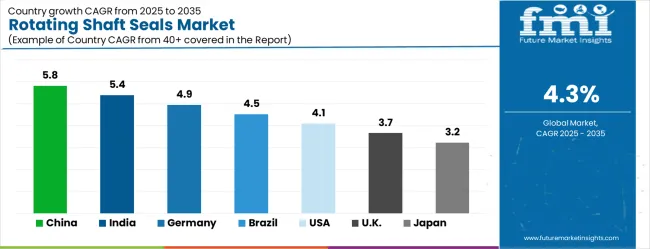
| Country | CAGR (2025-2035) |
|---|---|
| China | 5.8% |
| India | 5.4% |
| Germany | 4.9% |
| Brazil | 4.5% |
| USA | 4.1% |
| UK | 3.7% |
| Japan | 3.2% |
Regional synthesis reveals Asia-Pacific markets leading growth through manufacturing modernisation and automotive infrastructure development, while European countries maintain steady expansion supported by industrial technology advancement and automotive production requirements. North American markets show moderate growth driven by manufacturing applications and industrial equipment integration trends.
China establishes market leadership through aggressive manufacturing modernisation programs and comprehensive automotive infrastructure development, integrating advanced rotating shaft seals as standard components in vehicle production and industrial machinery applications. The country's 5.8% CAGR through 2035 reflects government initiatives promoting manufacturing technology and domestic automotive capabilities that mandate advanced sealing systems in production and industrial installations. Growth concentrates in major manufacturing centres, including Beijing, Shanghai, and Guangzhou, where industrial modernisation showcases integrated sealing systems that appeal to domestic manufacturers seeking advanced equipment protection and operational efficiency applications.
Chinese manufacturers are developing cost-effective rotating shaft seal solutions that combine domestic production advantages with advanced features, including enhanced material properties and extended service life capabilities. Distribution channels through automotive suppliers and industrial equipment companies expand market access, while government funding for manufacturing technology development supports adoption across diverse automotive and industrial segments.
Strategic Market Indicators:
In New Delhi, Mumbai, and Bangalore, automotive and industrial manufacturers are implementing advanced rotating shaft seals as standard equipment for vehicle production and machinery protection applications, driven by increasing manufacturing investment and modernisation programs that emphasise equipment reliability capabilities. The market is projected to demonstrate a 5.4% CAGR through 2035, supported by government manufacturing initiatives and automotive infrastructure development programs that promote advanced sealing systems for automotive and industrial facilities. Indian manufacturers are adopting rotating shaft seal systems that provide reliable equipment protection and performance optimisation features, particularly appealing in automotive production, where operational reliability represents critical manufacturing requirements.
Market expansion benefits from growing automotive manufacturing capabilities and international technology transfer agreements that enable domestic production of advanced sealing systems for automotive and industrial applications. Technology adoption follows patterns established in manufacturing equipment, where reliability and performance drive procurement decisions and operational deployment.
Market Intelligence Brief:
Germany's advanced manufacturing technology market demonstrates sophisticated rotating shaft seals deployment with documented operational effectiveness in automotive production and industrial machinery through integration with existing equipment systems and manufacturing infrastructure. The country leverages engineering expertise in sealing technology and automotive systems integration to maintain a 4.9% CAGR through 2035. Manufacturing centres, including Munich, Stuttgart, and Düsseldorf, showcase premium installations where rotating shaft seals integrate with comprehensive production platforms and quality management systems to optimise equipment protection and operational effectiveness.
German automotive contractors prioritise system reliability and performance standards in rotating shaft seal development, creating demand for premium systems with advanced features, including enhanced material durability and integration with manufacturing monitoring systems. The market benefits from established automotive infrastructure and a willingness to invest in advanced sealing technologies that provide long-term operational benefits and compliance with automotive performance requirements.
Market Intelligence Brief:
Brazil's market expansion benefits from diverse manufacturing demand, including automotive production in São Paulo and industrial equipment upgrades, as well as government manufacturing programs that increasingly incorporate advanced sealing solutions for automotive applications. The country maintains a 4.5% CAGR through 2035, driven by rising manufacturing investment and increasing recognition of rotating shaft seal technology benefits, including reliable equipment protection and reduced maintenance capabilities.
Market dynamics focus on cost-effective rotating shaft seal solutions that balance advanced sealing features with affordability considerations important to Brazilian manufacturers. Growing automotive production creates sustained demand for modern sealing systems in new manufacturing infrastructure and equipment modernisation projects.
Strategic Market Considerations:
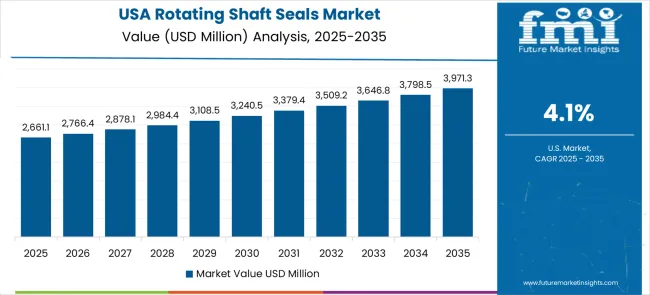
The USA market emphasises advanced rotating shaft seal features, including precision sealing systems and integration with comprehensive manufacturing platforms that manage equipment protection, maintenance scheduling, and performance monitoring applications through unified production systems. The country is projected to show a 4.1% CAGR through 2035, driven by manufacturing modernisation under industrial equipment upgrades and automotive demand for reliable sealing systems. American manufacturers prioritise operational effectiveness with rotating shaft seals delivering consistent equipment protection through advanced material algorithms and environmental adaptation capabilities.
Technology deployment channels include major industrial suppliers, specialised automotive equipment companies, and manufacturing procurement programs that support professional installation for complex industrial applications. Manufacturing platform integration capabilities with established production systems expand market appeal across diverse operational requirements seeking reliability and performance benefits.
Performance Metrics:
In Birmingham, Manchester, and other manufacturing centres, British automotive and industrial companies are implementing advanced rotating shaft seals to enhance equipment protection capabilities and support operational efficiency that aligns with manufacturing standards and performance optimisation protocols. The UK market is expected to demonstrate sustained growth with a 3.7% CAGR through 2035, driven by manufacturing modernisation programs and industrial equipment upgrades that emphasise advanced sealing systems for automotive and machinery applications. British manufacturers are prioritising rotating shaft seal systems that provide reliable equipment protection capabilities while maintaining compliance with performance standards and minimising maintenance requirements, particularly important in automotive production and industrial operations.
Market expansion benefits from government manufacturing procurement programs that mandate advanced sealing solutions in industrial equipment specifications, creating sustained demand across the UK's automotive and manufacturing sectors, where operational reliability and equipment protection represent critical requirements. The regulatory framework supports rotating shaft seal adoption through industrial equipment standards and automotive compliance requirements that promote advanced sealing systems aligned with national manufacturing objectives.
Strategic Market Indicators:
Japan demonstrates steady market development with a 3.2% CAGR through 2035, distinguished by manufacturing facilities' preference for high-quality rotating shaft seals that integrate seamlessly with existing production systems and provide reliable long-term operation in specialised automotive applications. The market prioritises advanced features, including precision sealing, operational durability, and integration with comprehensive manufacturing platforms that reflect Japanese automotive expectations for technological sophistication and operational excellence.
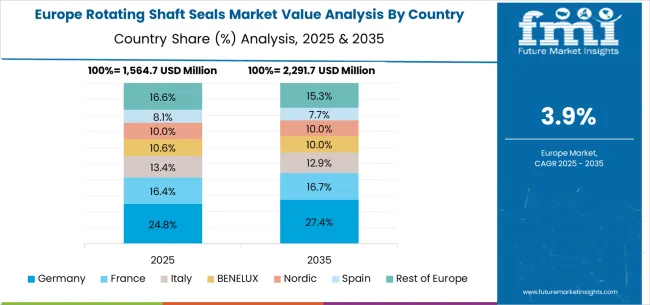
The Rotating Shaft Seals market in Europe is projected to grow from USD 1,392.9 million in 2025 to USD 2,125.8 million by 2035, registering a CAGR of 4.3% over the forecast period. Germany is expected to maintain its leadership position with a 27.8% market share in 2025, declining slightly to 27.2% by 2035, supported by its advanced automotive infrastructure and major manufacturing centres, including Stuttgart and Munich.
France follows with a 20.9% share in 2025, projected to reach 21.2% by 2035, driven by comprehensive automotive modernisation programs and manufacturing technology development initiatives. The United Kingdom holds an 18.6% share in 2025, expected to maintain 18.4% by 2035 through specialised automotive applications and manufacturing compliance requirements. Italy commands a 14.1% share, while Spain accounts for 9.7% in 2025. The Rest of Europe region is anticipated to gain momentum, expanding its collective share from 8.9% to 9.5% by 2035, attributed to increasing rotating shaft seal adoption in Nordic countries and emerging Eastern European automotive facilities implementing manufacturing modernisation programs.
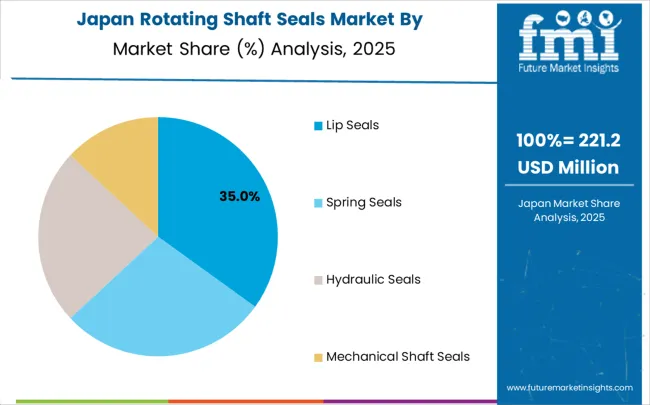
In Japan, the Rotating Shaft Seals market prioritises Lip Seals systems, which capture the dominant share of automotive and industrial installations through advanced features, including precision sealing optimisation and seamless integration with existing manufacturing infrastructure. Japanese automotive operators emphasise reliability, performance, and long-term operational excellence, creating demand for lip seal systems that provide equipment protection capabilities and adaptive sealing control based on operational requirements and performance scenarios. Mechanical shaft seals maintain a secondary market position primarily in specialised applications and aerospace installations where advanced protection functionality meets operational requirements without complex maintenance features.
Market Characteristics:
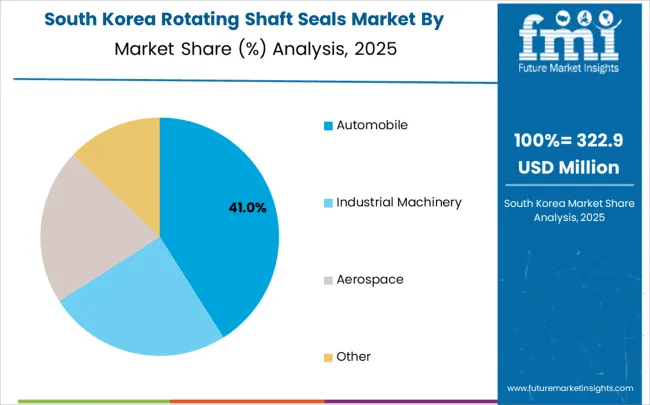
In South Korea, the market structure favours international industrial companies, including Parker, Trelleborg, and Bel Seal Engineering, which maintain dominant positions through comprehensive product portfolios and established manufacturing procurement networks supporting both automotive and industrial installations. These providers offer integrated solutions combining advanced rotating shaft seal systems with professional installation services and ongoing technical support that appeal to Korean manufacturers seeking reliable equipment protection systems. Local industrial contractors and system integrators capture moderate market share by providing localised service capabilities and competitive pricing for standard manufacturing installations. At the same time, domestic manufacturers focus on specialised applications and cost-effective solutions tailored to Korean automotive characteristics.
Channel Insights:
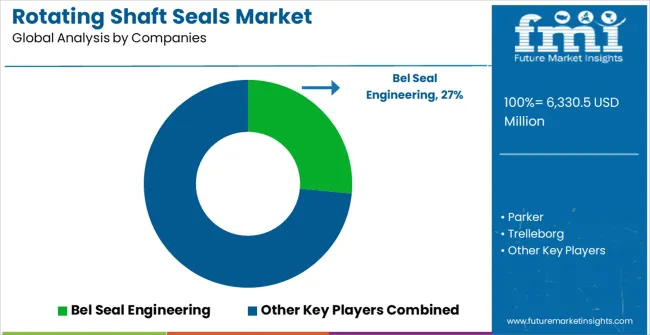
The Rotating Shaft Seals market operates with moderate concentration, featuring approximately 15-20 meaningful participants, where leading companies control roughly 50-55% of the global market share through established industrial relationships and comprehensive technology portfolios. Competition emphasises advanced sealing capabilities, system reliability, and manufacturing integration rather than price-based rivalry.
Market Leaders encompass Parker, Trelleborg, and Bel Seal Engineering, which maintain competitive advantages through extensive manufacturing expertise, global industrial networks, and comprehensive system integration capabilities that create customer switching costs and support premium pricing. These companies leverage decades of sealing technology experience and ongoing research investments to develop advanced rotating shaft seal systems with enhanced durability and equipment protection features.
Technology Challengers include Angst+Pfister, Fluorten, and Net Seals, which compete through specialised material technology focus and innovative sealing interfaces that appeal to manufacturing customers seeking advanced performance capabilities and operational flexibility. These companies differentiate through rapid technology development cycles and specialised industrial application focus.
Regional Specialists feature companies like Parjet, CinchSeal, Greene Tweed, Global O-Ring and Seal, and Max Spare, which focus on specific geographic markets and specialised applications, including hydraulic systems and integrated protection solutions. Market dynamics favour participants that combine reliable sealing hardware with advanced monitoring software, including performance tracking and predictive maintenance capabilities. Competitive pressure intensifies as traditional industrial equipment manufacturers expand into sealing systems. At the same time, specialised material companies challenge established players through innovative sealing solutions and cost-effective platforms targeting specialised manufacturing segments.
The global rotating shaft seals market represents a critical component segment within industrial sealing and equipment protection, projected to grow from USD 6,330.5 million in 2025 to USD 9,644.5 million by 2035 at a CAGR of 4.3%. Lip seals dominate the market, serving primarily automobile applications (the largest segment), followed by industrial machinery and aerospace sectors that demand reliable leakage prevention, extended service life, and operational efficiency. The market's expansion is driven by automotive production growth, industrial modernisation programs, and increasing emphasis on equipment protection and maintenance optimisation across critical manufacturing applications. Sustained growth requires coordinated efforts across automotive regulators, industry standards bodies, seal manufacturers, equipment integrators, and financial partners.
How Governments Could Accelerate Industrial Development and Market Adoption?
Automotive Industry Support: Establish automotive manufacturing incentives and production support programs that encourage domestic vehicle assembly, including tax credits for automotive component suppliers and rotating shaft seal manufacturers serving local automotive production facilities.
Manufacturing Infrastructure Development: Invest in industrial zones and specialised manufacturing hubs with advanced sealing technology production capabilities, including precision moulding facilities, material testing laboratories, and quality certification centres that support domestic seal manufacturing capabilities.
Technical Standards & Certification: Develop national quality standards for rotating shaft seals aligned with international automotive and industrial specifications (ISO/TS 16949, ASTM), ensuring domestic manufacturers can compete in global markets with certified quality credentials and regulatory compliance.
R&D Innovation Programs: Fund research initiatives focused on advanced sealing materials, temperature-resistant compounds, chemical compatibility improvements, and smart sealing technologies with integrated monitoring capabilities for predictive maintenance applications.
Skills Development & Training: Create technical education programs specialising in sealing technology, materials science, precision manufacturing, and quality control procedures essential for developing a skilled workforce in the sealing components industry.
How Industry Bodies Could Support Market Standardisation and Quality Excellence?
Performance Standards Development: Establish comprehensive quality standards for rotating shaft seals covering dimensional tolerances, material specifications, temperature resistance, chemical compatibility, and durability requirements that enable consistent performance comparisons across manufacturers.
Testing Protocols & Certification: Create standardised testing methodologies for seal performance validation, including leak rate testing, wear resistance evaluation, temperature cycling tests, and service life assessment procedures that support reliable procurement decisions.
Application Guidelines: Develop technical documentation for seal selection criteria, installation best practices, maintenance procedures, and troubleshooting guides that help end-users optimise seal performance and extend operational life across diverse applications.
Material Compatibility Standards: Establish compatibility matrices for seal materials with various fluids, temperatures, and operating conditions to guide the selection of proper seals for specific automotive, industrial, and aerospace applications.
Professional Certification Programs: Create training and certification courses for seal application engineers, maintenance technicians, and quality control personnel to ensure industry-wide competency in sealing technology and application expertise.
How Seal Manufacturers and Material Technology Providers Could Strengthen the Ecosystem?
Advanced Material Development: Innovate high-performance sealing materials, including fluoroelastomers, polyurethane compounds, PTFE-based materials, and hybrid composites that provide superior temperature resistance, chemical compatibility, and extended service life in demanding applications.
Manufacturing Process Innovation: Develop precision moulding technologies, automated quality control systems, surface treatment processes, and advanced curing methods that ensure consistent production of high-quality seals meeting stringent automotive and industrial specifications.
Smart Seal Integration: Incorporate condition monitoring capabilities, wear indicators, and IoT connectivity into rotating shaft seals to enable predictive maintenance, real-time performance monitoring, and operational optimisation for industrial and automotive applications.
Application-Specific Solutions: Create specialised seal designs for specific applications, including automotive transmissions, industrial pumps, aerospace systems, and heavy machinery that address unique performance requirements and operating environments.
Technical Support Infrastructure: Establish comprehensive customer support, including application engineering services, seal selection software tools, installation training programs, and field technical assistance to help customers achieve optimal sealing performance.
How Automotive and Industrial Equipment Manufacturers Could Navigate Market Evolution?
Integrated Design Approaches: Develop sealing system integration strategies that optimise equipment design around seal capabilities, including proper groove design, surface finish specifications, and installation procedures that maximise seal performance and equipment reliability.
Supplier Partnership Development: Build strategic relationships with seal manufacturers that provide early access to new technologies, collaborative product development opportunities, and guaranteed supply security for critical sealing applications requiring specialised performance characteristics.
Predictive Maintenance Integration: Implement condition monitoring systems that leverage smart sealing technologies to optimise equipment uptime, reduce unplanned maintenance, and improve overall operational effectiveness through proactive seal replacement scheduling.
Quality Assurance Programs: Establish comprehensive seal qualification procedures, including performance validation, compatibility testing, and supplier auditing processes that ensure consistent quality and reliability across sealing component supply chains.
Cost Optimisation Strategies: Develop total cost of ownership models that consider seal purchase price, installation costs, maintenance requirements, and downtime prevention to make informed decisions about sealing solutions that provide optimal value.
How Distribution Partners and Service Providers Could Navigate Supply Chain Dynamics?
Regional Distribution Networks: Establish comprehensive distribution capabilities, including inventory management systems, technical support resources, and rapid delivery networks that serve automotive manufacturers, industrial facilities, and maintenance service providers effectively.
Value-Added Services: Provide seal selection assistance, installation training, inventory management programs, and emergency replacement services that help customers optimise seal performance and minimise operational disruptions.
Technical Expertise Development: Build application engineering capabilities that help customers select appropriate seals for specific applications, troubleshoot sealing problems, and implement best practices for seal installation and maintenance.
Digital Platform Integration: Develop e-commerce platforms, technical databases, and customer portals that provide easy access to seal specifications, compatibility information, and ordering systems for improved customer service and operational efficiency.
Market Intelligence Services: Provide customers with market insights, technology trends, and application updates that help them make informed decisions about sealing solutions and stay current with industry developments.
How Investors and Financial Partners Could Unlock Market Value?
Manufacturing Capacity Expansion: Finance advanced production facilities, precision moulding equipment, and quality control systems that enable seal manufacturers to scale production capabilities and meet growing demand across automotive and industrial markets.
Material Technology Innovation: Provide venture capital and development funding for advanced material research, smart sealing technologies, and manufacturing process innovations that advance seal performance capabilities and create competitive advantages.
Market Expansion Capital: Support international market development initiatives, including regional manufacturing facilities, distribution networks, technical support infrastructure, and local partnerships in high-growth automotive and industrial markets.
Supply Chain Integration: Finance vertical integration strategies that combine seal manufacturing with raw material production, precision machining capabilities, and distribution networks to create more efficient and competitive sealing solutions supply chains.
Automotive Industry Consolidation: Facilitate strategic mergers and acquisitions that create larger, more capable sealing organisations with enhanced R&D capabilities, broader product portfolios, and global reach necessary to serve major automotive and industrial equipment manufacturers effectively.
| Item | Value |
|---|---|
| Quantitative Units | USD 6,330.5 million |
| Product Type | Lip Seals, Spring Seals, Hydraulic Seals, Mechanical Shaft Seals, Others |
| Application | Automobile, Industrial Machinery, Aerospace, Others |
| Regions Covered | North America, Europe, Asia Pacific, Latin America, Middle East & Africa |
| Countries Covered | China, India, Germany, Brazil, the USA, the UK, Japan, and 25+ additional countries |
| Key Companies Profiled | Bel Seal Engineering, Parker, Trelleborg, Angst+Pfister, Fluorten, Net Seals, Parjet, CinchSeal, Greene Tweed, Global O-Ring and Seal |
| Additional Attributes | Dollar sales by product type and application categories, regional adoption trends across North America, Europe, and Asia-Pacific, competitive landscape with industrial equipment manufacturers and technology providers, manufacturing preferences for sealing performance and system reliability, integration with production platforms and monitoring systems, innovations in sealing technology and material durability, and development of mechanical shaft seal solutions with enhanced protection and monitoring capabilities. |
The global rotating shaft seals market is estimated to be valued at USD 6,330.5 million in 2025.
The market size for the rotating shaft seals market is projected to reach USD 9,644.5 million by 2035.
The rotating shaft seals market is expected to grow at a 4.3% CAGR between 2025 and 2035.
The key product types in rotating shaft seals market are lip seals, spring seals, hydraulic seals and mechanical shaft seals.
In terms of application, automobile segment to command 40.0% share in the rotating shaft seals market in 2025.






Our Research Products

The "Full Research Suite" delivers actionable market intel, deep dives on markets or technologies, so clients act faster, cut risk, and unlock growth.

The Leaderboard benchmarks and ranks top vendors, classifying them as Established Leaders, Leading Challengers, or Disruptors & Challengers.

Locates where complements amplify value and substitutes erode it, forecasting net impact by horizon

We deliver granular, decision-grade intel: market sizing, 5-year forecasts, pricing, adoption, usage, revenue, and operational KPIs—plus competitor tracking, regulation, and value chains—across 60 countries broadly.

Spot the shifts before they hit your P&L. We track inflection points, adoption curves, pricing moves, and ecosystem plays to show where demand is heading, why it is changing, and what to do next across high-growth markets and disruptive tech

Real-time reads of user behavior. We track shifting priorities, perceptions of today’s and next-gen services, and provider experience, then pace how fast tech moves from trial to adoption, blending buyer, consumer, and channel inputs with social signals (#WhySwitch, #UX).

Partner with our analyst team to build a custom report designed around your business priorities. From analysing market trends to assessing competitors or crafting bespoke datasets, we tailor insights to your needs.
Supplier Intelligence
Discovery & Profiling
Capacity & Footprint
Performance & Risk
Compliance & Governance
Commercial Readiness
Who Supplies Whom
Scorecards & Shortlists
Playbooks & Docs
Category Intelligence
Definition & Scope
Demand & Use Cases
Cost Drivers
Market Structure
Supply Chain Map
Trade & Policy
Operating Norms
Deliverables
Buyer Intelligence
Account Basics
Spend & Scope
Procurement Model
Vendor Requirements
Terms & Policies
Entry Strategy
Pain Points & Triggers
Outputs
Pricing Analysis
Benchmarks
Trends
Should-Cost
Indexation
Landed Cost
Commercial Terms
Deliverables
Brand Analysis
Positioning & Value Prop
Share & Presence
Customer Evidence
Go-to-Market
Digital & Reputation
Compliance & Trust
KPIs & Gaps
Outputs
Full Research Suite comprises of:
Market outlook & trends analysis
Interviews & case studies
Strategic recommendations
Vendor profiles & capabilities analysis
5-year forecasts
8 regions and 60+ country-level data splits
Market segment data splits
12 months of continuous data updates
DELIVERED AS:
PDF EXCEL ONLINE
Rotating Phase Converter Market
Shaft Shredder Market
Camshaft Lifters Market Growth - Trends & Forecast 2025 to 2035
Camshaft Bearings Market
Crankshaft Position Sensor Market Growth – Trends & Forecast 2025 to 2035
Piston Seals Market Size, Growth, and Forecast 2025 to 2035
Polymer Seals Market Growth – Trends & Forecast 2025 to 2035
Padlock Seals Market
Aircraft Seals Market Size and Share Forecast Outlook 2025 to 2035
Flexible Shaft Couplings Market
Mechanical Shaft Seal Market Size and Share Forecast Outlook 2025 to 2035
Automotive Seals and Gaskets Market Size and Share Forecast Outlook 2025 to 2035
Mechanical Seals Market Growth - Trends & Forecast 2025 to 2035
Indicative Seals Market
Fixed Length Seals Market Size and Share Forecast Outlook 2025 to 2035
Wind Turbine Shaft Market
Demand for Camshaft Lifters in USA Size and Share Forecast Outlook 2025 to 2035
Demand for Camshaft Lifters in Japan Size and Share Forecast Outlook 2025 to 2035
Automotive Camshaft Market Size and Share Forecast Outlook 2025 to 2035
CFRP Propeller Shaft Market

Thank you!
You will receive an email from our Business Development Manager. Please be sure to check your SPAM/JUNK folder too.
Chat With
MaRIA